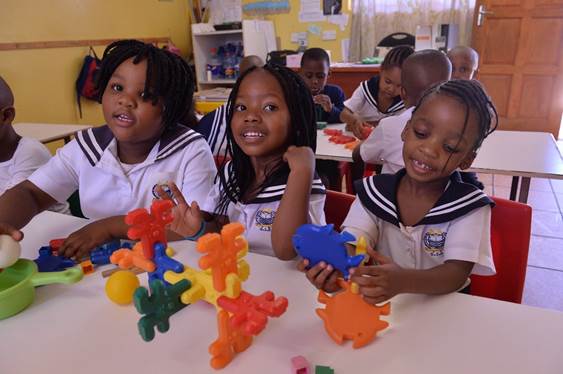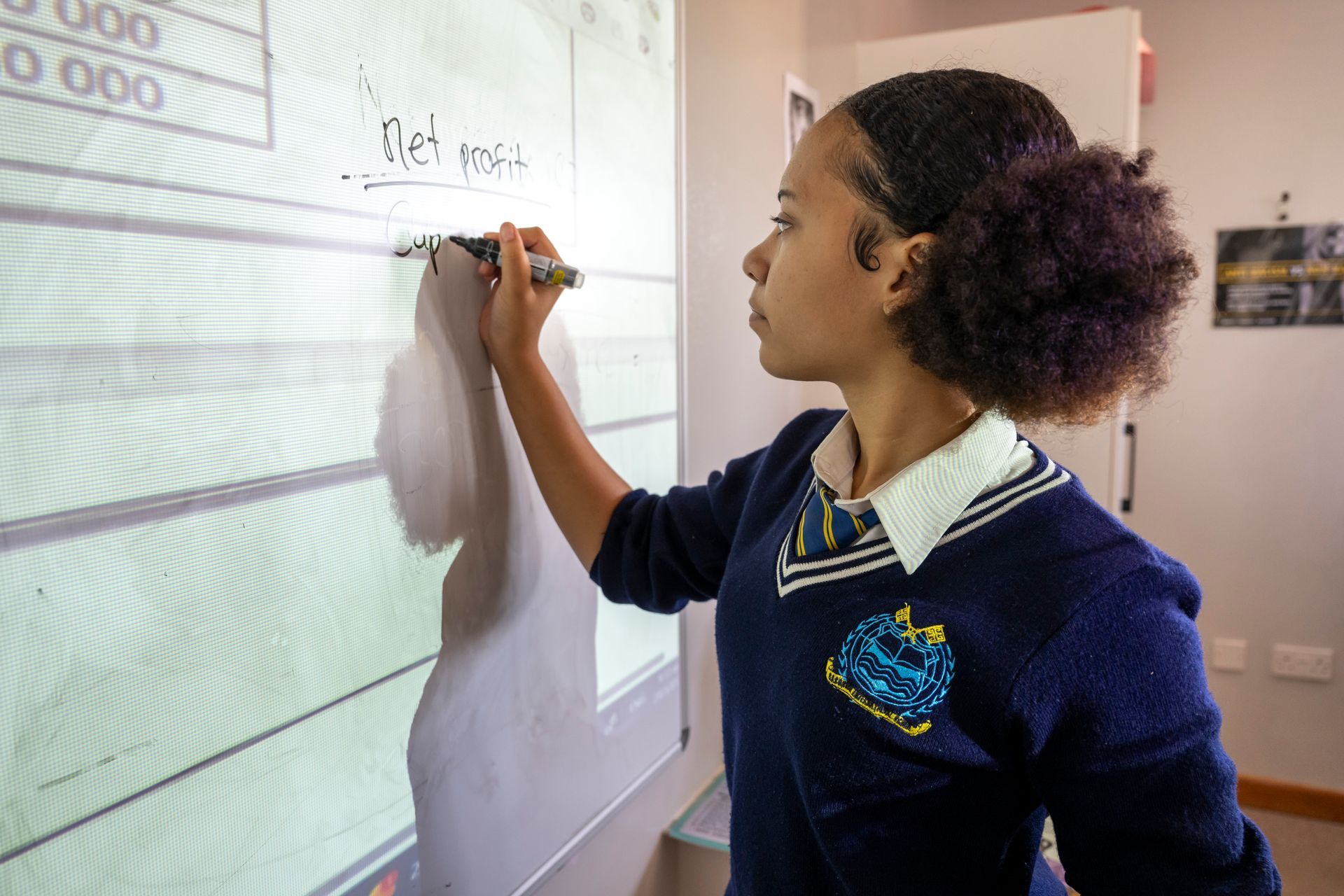Ages and Stages: How Children Adjust to Life and Education | News | GIS
August 23, 2019

As a private school in Botswana that offers creche
, junior
and senior primary
schooling, we’ve got a higher understanding of each child’s needs at every stage of their development. With qualified and passionate educators throughout our school, every pupil gets the attention they require for success and a brighter future.
Our reputation as a leading private school in Botswana has enabled us to contribute to the academic successes of many who pass through the doors of our classrooms. We’ve also come to form some strong relationships with these children and their parents, something that we believe truly sets us apart. Sharing information with the parents of our pupils is one of the ways we can ensure that they’re involved in their child’s development every step of the way. Here’s how your child adjusts to each stage of life and what you can do to help them along the way.
Two years of age
Our full-day creche is perfect for children as young as two years old. At this age, they are curious but also fearful and quite sensitive to separation from parents and their home environments. This means that routine is crucial for getting them settled. Although quite prone to separation anxiety at this stage of development, they need to discover their world. This means learning, playing and exploring. As a result, going to school is ideal for helping your child flourish and pave a sound foundation for their education.
Between the ages of three and five
This is also known as the busy period where your child learns to cut, draw, sing and express themselves. At school, they will be learning about numbers, letters, shapes and directions. This means that you should be reiterating these at home to make sure your child remembers them. There are also a lot of questions asked at this stage as your little one attempts to reason with the workings of the world. You should encourage this curiosity and answer questions to the best of your ability and in a way that they will understand.
Although you might want to push learning activities at home, make sure you give your child ample time to play. At this age, they learn a great deal from playing. Reinforce things that your child does well in order to boost their self-esteem.
From six to eight
Your child has now started junior school and your baby has blossomed overnight. At this stage, they’re navigating homework, breaktimes and social relationships with their friends. They will have good, bad and even frustrating days. Some might be eager to go to school each day, whilst others are certainly more overwhelmed. Although “big school” can seem like a scary prospect, a good routine is a fantastic way to make the transition easier. Help your child get ready for the next day the night before and try and foster a healthy mindset to things like homework and extra murals. Be consistent with discipline at this stage so that you can set the tone for how they ought to behave.
Nine to eleven
As they approach senior school level, children at this age walk the line between being little and rather mature. Some might even be starting puberty which is of course accompanied by lots of changes. At this age, children are able to think in a logical way and might enjoy tasks that incorporate some sort of responsibility. Parents should attempt to give them manageable tasks that hone their understanding of what it means to be responsible. Things like chores or caring for a pet or plant are a good starting point. Communication at this stage is key, particularly when things like puberty begin. Try and make sure the lines of communication are healthy and open ones so that your child is more likely to reach out to you if need be.
Twelve and thirteen
When your child becomes a teenager, you’ll be dealing with a different person from day to day. As they go through puberty and become more independent, they find their voice and form very strong opinions. Your child needs to know that they have your support, which means communicating and encouraging them at every crossroad. There might even be a girlfriend or boyfriend at this stage so be prepared.
Supporting your child every step of the way
At Gaborone International School, a team of
esteemed educators
is qualified and passionate about helping your child reach their full potential.
If you’re interested in an education that prepares your child for a bright and successful future, please click on one of the buttons below.
To read more insightful blogs from our teachers and educational experts, click here
.
To find out more about Gaborone International School and the work we do, click here
.

In today’s connected world, young people grow up in a digital society where learning, friendships, and entertainment all happen online. At GIS, we see this not only as a reality to manage, but as an opportunity to empower our learners. Digital citizenship education is about much more than keeping students safe, it is about equipping them to use technology ethically, confidently, and effectively so they can thrive in the digital age. Why Digital Citizenship Matters Every post, click, or share leaves a digital footprint. These footprints can shape a learner’s reputation, relationships, and even their future opportunities. At GIS, students are taught to manage their online presence responsibly and make ethical choices. Through ICT lessons and the use of integrated platforms such as Microsoft Teams, Stasy, MAP, and ADvLEARN , learners don’t just study the theory of online safety, they practise it every day. Each GIS student logs in with personalised accounts, develops strong digital ethics, and is discouraged from behaviours that could lead to cybercrime.

Selecting a school for your child is one of the most important decisions you’ll make as a parent. A good school nurtures not just academic growth, but also social, emotional, and moral development. A good school does not only allow parents to dream of possibilities for their children but also assist in making those dreams become realities! With so many options available, public and private, it’s essential to know what to look for in making this important decision. During your next visit to a prospective school for your precious child, put some consideration towards the following important aspects of a school: 1. A Strong Educational Foundation Check for a clear and balanced curriculum that emphasizes core subjects like reading, math, science, and the arts. Ask about teaching methods and how the school measures progress. Look for schools that promote critical thinking, problem-solving, and creativity. Reputable schools produce excellent results, annually. At GIS we use Guided Readers, a digital platform for Standard 1-3 which gauges the reading ability of individual students. We also use ADvLEARN in Standard 7, Form 1-4 which uses adaptive technology to give tailor-made mathematics exercises to meet students where they are at, building them up to where they should be and beyond! Our campus is equipped with seven ICT labs, five physics/chemistry labs and two robotics labs. Our teachers are all equipped with laptos, projectors and sound bars to bring the class to life! We also have drones, VR-headsets, lazar cutters and 3-D printers – equipping our students to gain valuable experiences, preparing them for the real world! 2. Dedicated and Qualified Staff Meet the teachers and staff. Are they approachable, qualified, and passionate about education? A supportive, well-trained teaching staff can make a huge difference in your child’s learning experience. At GIS, all our teachers are qualified with 25% of our staff holding post-graduate degrees i.e. Masters and Honours Degrees. Another 46% hold degrees i.e. B.A, BEd or BSc. with the remainder of 29% holding a teaching diploma or equivalent. Our teachers enjoy regular training opportunities through our internal training platform, Sirius. Our teachers are thus life-long learners themselves, passionate about education and best-practice. We care about our individual students’ wellbeing and remain in close contact with parents throughout their child’s educational journey with us. 3. Registration, Health and Safety It is imperative to select a school which is registered with the necessary authorities as an operating school. All schools are bound by specific health and safety regulations with proven steps taken to comply. GIS High School is registered with Cambridge. The Primary School is registered with the Ministry of Education for PSLE examinations at the end of Standard 7. Being part of ADvTECH means that the school is subjected to rigorous health and safety protocol with internal and external audits being carried out annually. 4. A Positive School Culture Tour the school to observe the environment. Are students engaged and respectful? Do teachers and administrators seem enthusiastic and caring? A positive, inclusive atmosphere contributes significantly to a child’s confidence and motivation. We are proud to share that GIS-students hail from 32 different countries. We truly celebrate our unique cultures and individual strengths. Even so, we are grounded in Botswana values, taking care of our community and environment. Have a look out for our community service projects and participation in environmental programmes often shared on social media. 4. Student Support and Enrichment Opportunities Look for a school that provides more than just academics—such as counselling services, extracurricular activities, clubs, sports, and arts programs. These contribute to a well-rounded education and help children discover their interests and talents. At GIS, we have an on-site psychologist who assist with academic support and counselling. We also have a dedicated Deputy Principal of Pastoral Care and Discipline, ensuring that students are guided through each phase while reaching their full potential. Students can select from a vast range of extra-mural activities including but not limited to soccer, netball, swimming, athletics, basketball, table tennis, spelling bee competitions, maths Olympiads, debate and moot court. 5. Parental Involvement Strong schools often welcome parent engagement. Whether through regular communication or active partnerships between home and school, it truly supports student success. At the end of every academic term, parents are invited to our campus to meet with their children’s teachers to discuss the term’s progress and results. Parents are also invited to termly Coffee with the Heads of Schools during which important updates are shared. Parents are always welcome to reach out to our teachers and school management to support where needed. Final Thoughts Choosing the right school is a deeply personal decision. Take your time to visit, ask questions, and trust your instincts. Remember: the best school is the one where your child feels safe, supported, and inspired to learn! Allow us to dream with you and assist your child to ascend to their aspirations! You are invited to visit our school and to meet our principals.

At GIS Pre-Primary we follow the Reggio Emilia approach, and we believe that learning flourishes through collaboration among educators, learners, and families. Our environment is designed to spark curiosity, creativity, and meaningful connections. Central to our philosophy is the idea that parents are not just supporters of education but active partners in the learning journey. 1 . Open Communication We prioritize clear and consistent communication. Each term begins with a newsletter outlining key calendar events, followed by timely WhatsApp reminders to keep families informed. Monthly class overviews help parents stay engaged with their child’s learning, identify areas needing support, and collaborate with teachers before new topics are introduced. 2. Meaningful Parent Engagement We actively invite parents into the classroom to observe and participate in hands-on learning experiences. Celebrations like Father’s Day and Mother’s Day are honored, while events such as Sports Day offer opportunities for parents to join in the fun. When children see their parents involved, it reinforces a sense of encouragement and shared purpose, sending a powerful message that their education is deeply valued. 3 . Supporting Home Learning Learning does not stop at the school gate. Through weekend projects and real-world experiences, like gardening, baking, or museum visits, parents help children explore their world. Learners document these moments through photos and videos, fostering reflection, independence, and self-motivation. Watching themselves and their peers engaged in discovery empowers children to take ownership of their growth. 4. Celebrating an Inclusive Community At GIS, we proudly celebrate the diversity of our school community by hosting a range of events at varied times, ensuring that everyone can participate and feel included. Our Family Fun Day is a vibrant example of this, bringing together families from all walks of life to share in the rich cultural heritage, diverse experiences, and unique perspectives that make our school so special. These events not only foster a sense of belonging and connection among families but also create a warm and inclusive environment that welcomes and values every individual. Strong parent–teacher partnerships are the foundation of a thriving learning environment. At GIS, we’re committed to nurturing these connections, ensuring that every child is supported, inspired, and surrounded by a community that believes in their potential.
